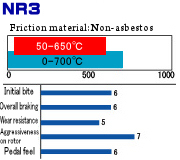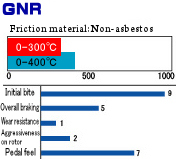| Non-asbestos group(non-steel ~ low steel) |
 |
 |
 |
 |
| NR1(bench-graph) |
NR2(bench-graph) |
NR3(bench-graph) |
No data |
| Rear anti-lock friction material |
Rear control standard friction material |
Standard friction material for rear wheel drive
vehicles |
Rear friction material for side lock |
| Carbon group(low steel ~ high steel) |
 |
 |
 |
 |
| CC1(bench-graph) |
CC2(bench-graph) |
CC5(bench-graph) |
CC6(bench-graph) |
| Prioritizing controllability, racing use |
Prioritizing controllability, racing use |
Prioritizing high temperature high braking force ,
racing use |
Prioritizing high temperature high braking force ,
racing use |
| For the use at the high temperature by the circuit run, I give prevention
of detachment processing. |
| Semi-metallic group(middle steel ~ high steel) |
 |
 |
 |
 |
| SC1(bench-graph) |
SC2(bench-graph) |
SC3(bench-graph) |
SC4(bench-graph) |
| Light weight vehicles, sprint racing use |
Light weight vehicles, sprint racing use |
Light weight vehicles, sprint racing use |
Light weight vehicles, sprint racing use |
 |
 |
No image |
No image |
| SC5(bench-graph) |
SC6(bench-graph) |
No data |
No data |
| Prioritizing controllability, high temperature
racing use |
Prioritizing braking force, high temperature racing
use |
No data |
No data |
| For the use at the high temperature by the circuit run, I give prevention
of detachment processing. |
| Durable metal group(high metal ~
full metal) |
 |
 |
 |
 |
| MF1(bench-graph) |
MF2(bench-graph) |
MF3(bench-graph) |
No data |
| Prioritizing high temperature stability, endurance
racing use |
Prioritizing high temperature stability, endurance
racing use |
Prioritizing high temperature stability, endurance
racing use |
Rear friction material for side lock |
| For the use at the high temperature by the circuit run, I give prevention
of detachment processing. |